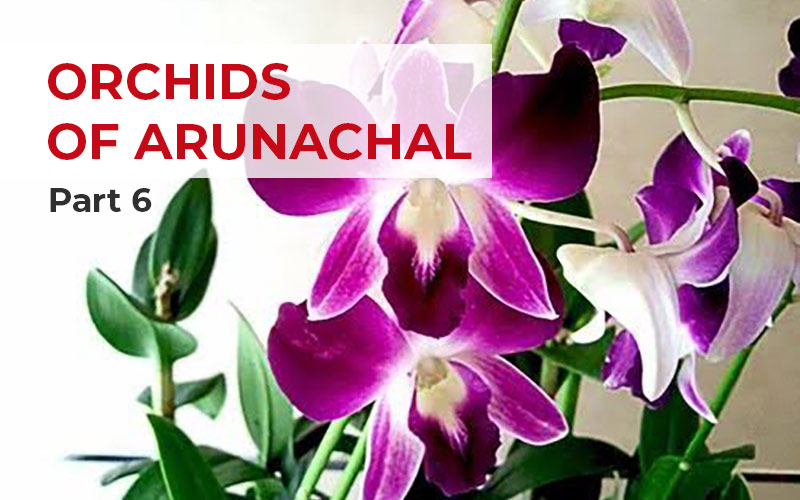
ORCHIDS OF ARUNACHAL - Part 6
One of the exotic plants that are commonly used for both
ornamental and medicinal purposes is orchids. The plant is a member of the
Orchidae family, which is the second-largest family group of flowering plants
after the sunflower family. More than 500 species and genera of distinct
variations of orchids exist worldwide, some of which are common and wild,
others of which are uncommon and endemic to a particular area, and yet others
of which have not yet been identified.
Arunachal Pradesh, known as "The Orchid State of India," is home to more than 600 different species of orchids, which makes up around 40% of India's entire orchid population. Highlighted in the article are a few of the orchid species found in Arunachal Pradesh.
The
Hidden Zuexine
Scientific name: Zeuxine clandestina Blume, also known as the Hidden Zuexine, is classified as belonging to the Orchidaceae family and Spiranthoideae subfamily, under the Goodyereae tribe and Cheirostylidinae subtribe. It is a Clandestina species under the genus Zeuxine.m, which is a monopodial plant that inhabits terrestrial land and can be found between 80 and 700 metres above sea level. The flowering period of this orchid species begins in September and ends in September. It has a 2.5-mm-wide flower that is whitish in colour and blooms in the summer, and its inflorescence is a raceme with spikes.
The
Yellow Zeuxine
Scientifically known as Zeuxine flava, is an orchid plant of the flava species and genus Zeuxine. Its subfamily is Spiranthoideae; its tribe is Goodyereae; and its subtribe is Cheirostylidinae. Vernacular names for the yellow zeuxine include Ueang Din Noi Pak Lueang in Thailand and Huang Hua Xian Zhu Lan in China. It is monopodial in habit and inhabits the terrestrial environment at an altitude of 500 to 1000 metres. Its flowering period begins in May and concludes in July, and it can be seen thriving in tropical forests around spring or summer when it blooms. Its flowers are 2-3 mm across, yellowish-green to greenish-white in colour, and have a raceme-shaped inflorescence.
The
Goodyera-Like Zeuxine
The Goodyera-Like Zeuxine, scientifically termed, Zeuxine goodyeroides, belongs to the Spiranthoideae subfamily, Goodyereae tribe, Cheirostylidinae subtribe, Zeuxine genus, and Goodyeroides species. It dwells in the terrestrial zone at an altitude of 1000–1200 metres and has a monopodial behaviour. Autumn and winter are when flowers bloom, and that season lasts from October to February and they prefer the sub-tropical forest type. The inflorescence is spike-shaped, and the flower is green with a pinkish tinge, while the flower size is 9–10 mm. Two districts, Lower Subansiri and Upper Subansiri, in the state of Arunachal Pradesh, are home to its germplasm and Tippi Orchid Center in West Kameng, Arunachal Pradesh is the orchidarium where it is preserved.
Lindley's
Lawn Orchid
Zeuxine lindleyana is the scientific name of Lindley's Lawn Orchid and is classified as belonging to the genus Zeuxine, species Lindleyana, tribe Goodyereae, subtribe Cheirostylidinae, family Orchidaceae, and subfamily Spiranthoideae. Its habitat is terrestrial regions at an altitude of 300 metres minimum and 800 metres maximum, and it has a monopodial habit. Spring, Winter, and Autumn are the flower's seasons, and March through May are the blossoming months. East Kameng, Tirap, and West Kameng are the districts in the state of Arunachal Pradesh that have access to its germplasm. The orchid prefers tropical types of forest, has a raceme-shaped inflorescence, flowers that are 1-1.2 cm wide, and its flower colour is pale green with pink undertones.
Long-Lipped
Zeuxine
Its scientific name is Zeuxine longilabris and is commonly known by the name Long-Lipped Zeuxine. It is a plant that belongs to the Orchidaceae family, the Spiranthoideae subfamily, the Goodyereae tribe, the Cheirostylidinae tribe, the Genus Zeuxine, and the Species longilabris. The specimens of this species were collected by Dr S. N. Hegde from the collection site in Sessa, Arunachal Pradesh. The plant grows monopodially and inhabits the terrestrial zone at an altitude of between 200 and 500 metres. It begins to bloom in March and finishes in May throughout the flowering season, which lasts from spring to winter. They prefer tropical forests, and the plant is purple in colour with flowers that are 1-1.5 cm across and have a raceme-shaped inflorescence.
Reference(s): Orchid Flora of Arunachal Pradesh H. J. Chowdhery
1998; IOSPE (Internet Orchid Species Photo Encyclopedia); Orchids of Arunachal
Pradesh S. N. Hegde 1984; An Illustrated Guide to the Orchids of Bhutan Dhan
Bahadur Gurung; Terrestrial Orchids Naresh Swami; Orchids of Ziro Arunachal
Pradesh Naresh Swami; www.efloras.org; www.theplantlist.org;
https://www.indiabiodiversity.org; https://www.jstor.org; www.flowersofindia.net; www.indianforester.co.in; http://www.academia.edu;
https://www.researchgate.net; www.academia.edu; www.jjbotany.com;
flora-peninsula-indica.ces.iisc.ac.in; www.flowersofindia.net;
keralaplants.in.
Disclaimer: The opinions expressed in this article are those of the author's. They do not purport to reflect the opinions or views of The Critical Script or its editor.

Newsletter!!!
Subscribe to our weekly Newsletter and stay tuned.

















Related Comments